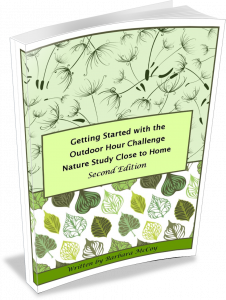I was reading the “How to Use This Book” section of the Handbook of Nature Study again this week and I found something that is worth repeating at this point in our challenges.
“Make the lesson an investigation and make the pupils feel that they are investigators…….The ‘leading thought’ embodies some of the points which should be in the teacher’s mind while giving the lesson; it should not be read or declared to the pupils……..The outlines for observations herein given by no means cover all of the observations possible; they are meant to suggest to the teacher observations of her own, rather than to be followed slavishly….If the questions do not inspire the child to investigate, they are useless.” page 23
As the guide in our child’s nature study we need to remember to use the lesson and observation sections of the book as a guide to make nature study flow gently and naturally, not as a lecture with questions at the end.
Magnifier Tripod
Loupe 8x
Stand magnifier
Plastic bug magnifier

Outdoor Hour Challenge #8
Up Close and Personal
“….but in nature-study, the observation of form is for the purpose of better understanding life.” page 8.
1. Read the Handbook of Nature Study pages 7-8, “Nature-Study and Object Lessons“. Also read “The Lens, Microscope, and Field Glass as Helps in Nature Study” on pg 9-10.
“In elementary grades, nature study deals with objects which the children can see with the naked eye. However, a lens is a help in almost all of this work because it is such a joy to the child to gaze at the wonders it reveals.”
If you do not have a simple magnifying lens as part of your science equipment, this might be a good time to invest in one you can easily carry in your pocket or backpack. We rarely take our magnifying lens with us on hikes but we do use it to look at things we find and bring home. We also find it is essential for a study of insects.
Make sure to pick another subject in your focus area to share with your children. Read the observation suggestions for that subject before you have your outdoor time so you can have them in mind as you do your observations this week.
“ Adults should realize that the most valuable thing children can learn is what they discover themselves about the world they live in. Once they experience first-hand the wonder of nature, they will want to make nature observation a life-long habit. All people are supposed to be observers of nature and there’s no excuse for living in a world so full of amazing plants and animals and not be interested in them.” Charlotte Mason, volume 1 page 61
2. Spend your 10 to 15 minutes of outdoor time this week looking closely at objects in your own yard. Encourage your child to find an interesting object to investigate. If you can find something that relates to your focus area, your child will gain a totally new perspective of study. For example if your focus area is trees, find a leaf or bud or a piece of bark to look at with the hand lens. Without a lens you can still examine an object closely if you take a few minutes to slow down and focus on just one small part of it.
3. After your outdoor time, take a few minutes to informally talk about your experiences. Make note of any additional research that needs to be done for things your child is interested in.
4. Give an opportunity for a nature journal entry. Have you started your own nature journal yet? Add anything new to your list of items observed in your focus area that you are keeping in your nature journal.
5. Add any items to your collection that you discovered during your nature time. If you need more information on making a collection, see Challenge #6. If you are making a personalized field guide with your children, gather the materials and make your next card, see Challenge #7.
This challenge is found in the Getting Started ebook which is included in every level of membership. The ebook provides the challenge as shown above as well as custom notebook pages for your follow up nature journal if desired.





















